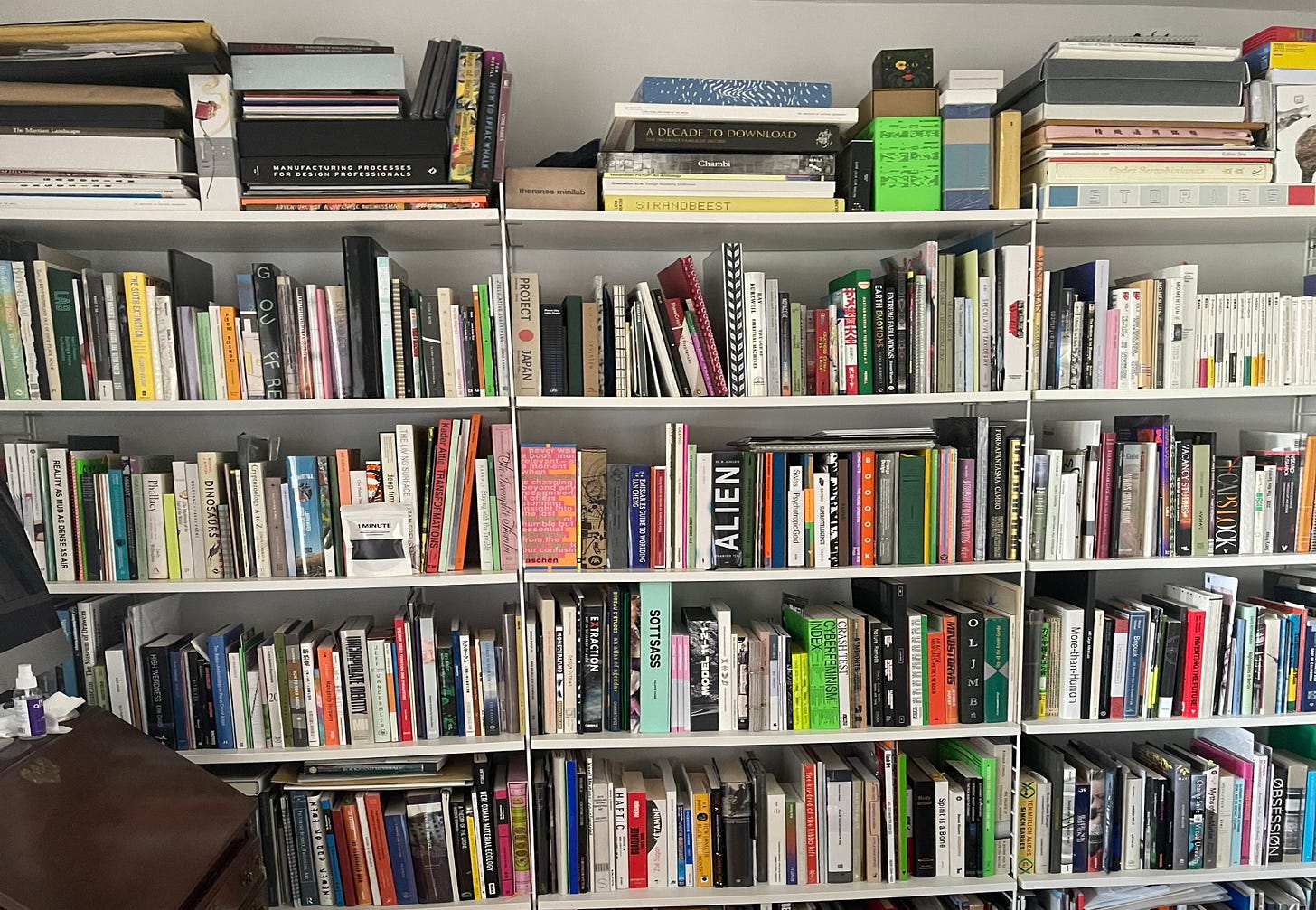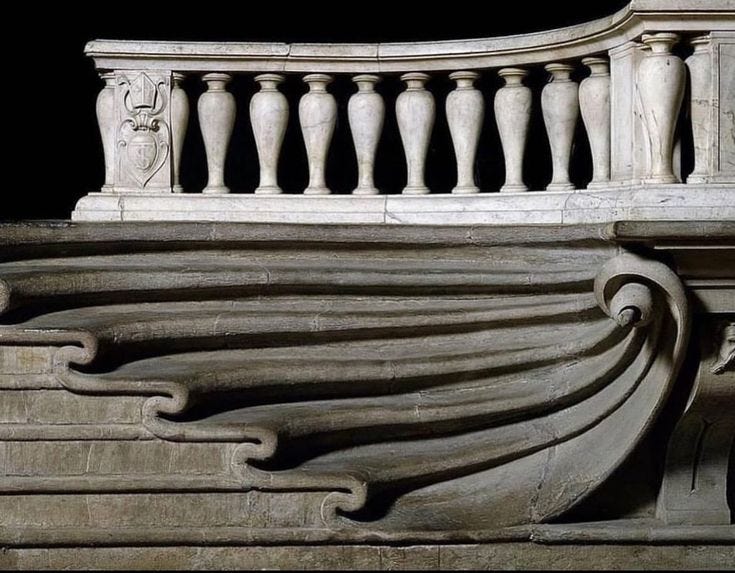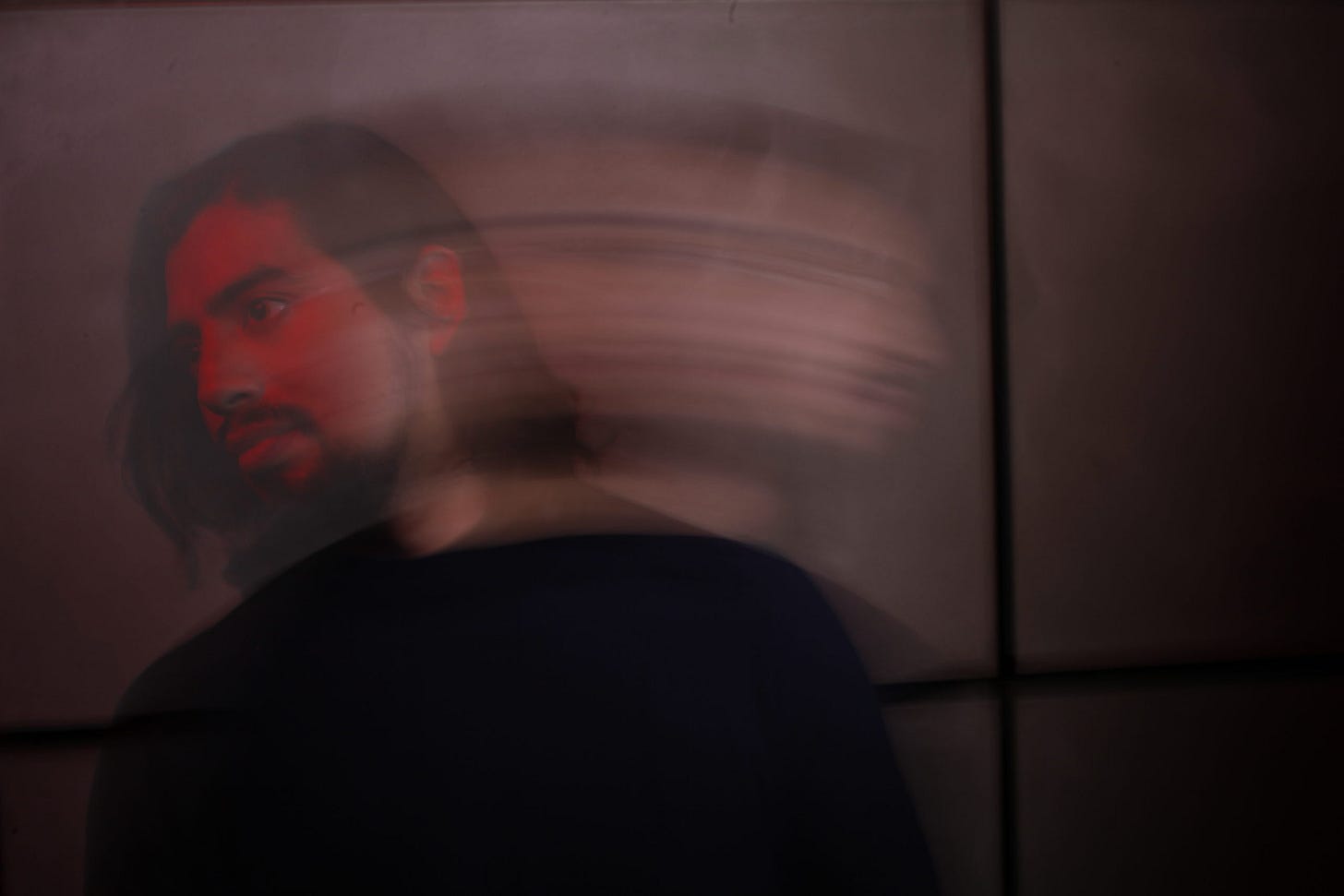Curator Interview: Oscar Salguero
Exploring how curiosity, research, and material traces inform curatorial practice.
If you are reading this and have yet to subscribe, join this community of artists, designers, and multi-creative hyphenates who are curious about how ideas evolve through process.
In this episode of Node, writer and host Maxine Apolito interviews curator, researcher, and archivist Oscar Salguero. Salguero discusses his recent show, NEO MINERALIA, his use of fictional narratives to understand our current era, and his archive of alternative interspecies books that challenge our notion of history. This interview represents the framework in action introduced in episode 001 Networks of Collective Intelligence, exploring how an art practice, exhibition, or research question can recreate a new ecosystem for thought considering the core pillars of Society, Nature, and Technology. If you haven't read episode 001 yet, check it out before diving into this interview.
Maxine Apolito So excited to be speaking with you this morning. I want to start by asking you if you can share a bit about yourself and the projects you have been working on before we begin to dive into your latest show NEO MINERALIA.
Oscar Salguero Sure, back during my college days studying Industrial Design at Virginia Tech, I became very curious about what other artists were doing, or what other kinds of philosophies or design thinking trends were happening around. At school, I would take time to present to my classmates different reports on things that were happening in alternative fields that interested me, such as speculative design, which at the time was becoming sort of a provocative subject to talk about.
It was really fascinating because it was kind of a hybrid design field that was tapping into biotechnology, AI, and climate change… all at the same time.
It made me more conscious about my studies in industrial design, a field concerned with producing or making more things, and how I could be more critical about it. I believe speculative thinking helped me sort of expand my vision around what I do today.
M I always find it so interesting as well how people get into their niche areas of interest, thanks for sharing.
Can you also tell us more about the work you're doing today? About your collection of books, and more into this idea of speculative design, practices, fiction, and how that plays into your practice today. I learned so much during my visit to Interspecies Library and want to share a piece of those narratives with this audience.

O Since I was a kid, I've been fascinated by books. In recent years, I started noticing that many artists who were doing speculative design projects also were producing books to expand on their ideas. Many times, these books were ignored or produced in really small amounts.
So I started slowly, sort of gathering them and seeing them as these really special documents of our time, our era. This habit eventually led me to start the Interspecies Library which has grown quite a bit along the way.
M I follow the Interspecies Library account and from what I see the idea was previously also an exhibition that you curated at the Center for Book Arts here in New York, can you share a bit more about this?
O So this was my first curated show in 2021, which I called Interspecies Futures (also a book produced that year).
The idea was to share artists’ books that uniquely highlighted our growing and conflicting relationships with other species, a selection that was really forward-thinking at the time. This is when I started calling my practice the “Antilibrary,” which was, overall, an experiment in studying how books can become predictive artifacts or documents.
In a strange way, I asked myself, how can I identify patterns of societal shifts, or cultural shifts just by analyzing the books that are being produced? So, for me, books became a barometer of culture.
The focus was not just on books that were mainstream, but especially those that were produced at the outer edges of research and experimentation because they dealt with topics that are future-focused, and maybe not easy to understand right now.
M There seems to be a pattern here in your work with the idea of time and future predictive artifacts, what do you think interests you in this idea of preservation through the art of books?
O Yeah, that's an interesting one. Because I recently came up with a term. I actually just put it on my Twitter. I use Twitter to document any random or weird thoughts that I think I might want to evolve in the future. I just put it out there.
So my latest tweet is a concept I call ‘print fiction’. For me, Print-fiction is representative of what I'm doing. We are familiar with science fiction, and non-fiction; there are even genres called theory fiction, climate fiction, and so on. I think what I'm doing, in some way, can be called Print-fiction.
So print fiction refers to printed books that relate to an alternative reality. In a way, these publications are like “out-of-place” artifacts that could make sense in a different world, but not so much directly in our current one. This is really a strange idea because it challenges our notion of history.
There is real history that we're all experiencing, and then there's a genre that became popular in the 20th century called ‘alternative history’. Alternative history is fiction books that tell stories of what would have happened if certain historical events took a different turn, and of what kind of world we could have lived in.
Print-fiction is the use of the book itself presented as an artifact from an alternative history. And for me, a lot of these books that I'm curating and presenting belong to some alternative history. Their goal is to tease us, to provoke us with evidence of either a reality we can live in or one we don’t want to live in.
Exhibition: NEO MINERALIA
M A fascinating perspective. I can see how this all connects back to NEO MINERALIA as I know a lot of the subjects you are speaking about really inform your latest exhibition at the Center for Craft. Can you tell us what this work is all about?
O Along with my exploration of books on speculative futures, I also started researching the subject of geology and rocks, which eventually brought me to the main concept of the show.
I began noticing that a growing number of artists concerned with our effects on the planet started to turn to rocks as artifacts of deep time, almost as traces of what we're leaving behind.
That observation is really strange actually because, in the history of humans and rocks, there has never been a case where an international group of humans is simultaneously fascinated with the idea of imitating rocks. The norm was always to either use rocks as materials to create things with (sculptures, buildings) or as precious artifacts for contemplation, as in ancient China or Korea, for example, where they would find the most beautiful rocks that resembled mountains or people and place them on a pedestal for further appreciation. Or even way back in the Stone Age when rocks were used as tools or when the first carvings of animals were done in caves.
As humans we've always had a deep and close relationship with rocks.
This got me to thinking: what will rocks be like in 10,000 years? So I was inspired to gather case studies and to approach artists who were already applying these ideas in their works, which eventually became part of the show NEO MINERALIA.
M That's such an interesting perspective to think about humans and the traces we leave behind through our habits, looking at that through the lens of a rock and what that says about our culture today.
O Yes, so in 2006, a scientist discovered a rock in Hawaii that had plastic melted into it. This was the first known evidence of a rock mixed with human-made materials. They called this rock a “plastiglomerate,” which is being acknowledged as a new type of hybrid rock today. You can see more examples like this being found around the world. I saw that recently a new plastiglomerate was found in Brazil and many more in Korea in the last few years.
M After viewing your post on Instagram I noticed that in creating these new rock categories you created two distinct categorizations, Synthetic and Digital. Can you speak to this a bit?
O This project is an attempt to present two new categories of rocks. Traditionally there are three categories of rocks (igneous, metamorphic, and sedimentary). First, Synthetic rocks are those that have some human-made materials in them, along with different forms of inorganic matter. Then, there are Digital rocks, which result from simulated designs of geological formations for digital environments. These are achieved with 3D scanning, 3D modeling, 3D printing, and even with the aid of AI. These digital rocks are created in the likeness of real rocks, but only for virtual environments and worlds.
M In this process the show exhibited rocks that sit in those 2 categories you mentioned. Something I found interesting especially in gaining a more global perspective with this as these relationships can vary depending on culture or tradition, you work with an international set of artists who are located in different geographic locations. Can you speak more about the methodology?
O As this is a phenomenon that is not specific to one location, the selection of artists is from all over: from Japan, Korea, Brazil, Poland, Mexico, Australia, etc. For me, it was super important to represent artists from different disciplines, as well. Some are jewelry makers, architects, conceptual artists, strategists, etc.
M Not all node readers will have the chance to go and view the exhibition at The Center for Craft so I wanted to ask you if you can give us a walkthrough of how you would want people to experience this work. So first how it is currently being presented and lastly how would you want to extend this work beyond the exhibition, as exhibitions usually tend to be temporary?
O Yeah, that's an excellent question because, yes, exhibitions are temporary. So ideally, of course, it should be viewed in person because of the impact of seeing the rocks and minerals materialize in front of you. It’s kind of shocking to see them up close, you get to see the intricacies of their surfaces and textures.
If I had another chance I would want to bring it to New York. That would be incredible. I also think it's important to show the pieces as specimens, similar to the way it's presented now at the Center for Craft: with an info plaque in front of the rocks. Showing it like this mimics the way you would see it in a Hall of Gems and Minerals at a natural history museum: with the name of the rock, the coordinates where it was found, and in what era it was formed.
I think it plays with the concept of future archaeology. Like what happens when future archaeologists find these rocks in the wild, maybe even hundreds or thousands of years from today.
M I like the idea of presenting the specimens almost as if it would be presented in a real-world context. What about the digital rocks
O That was at first a struggle: thinking about how to present these rocks in their digital environment where there are other physical rocks present. So I decided to display them on LCD screens. But off-the-shelf LCD screens, like those that come without any kind of outer case or frame that protects them, are exactly how you would get them directly from the factory.
O The reason I did that is that it was a way to express that even the digital artifacts we experience need to manifest through some physical medium. In this case, LCD screens are also made and composed of crystals and minerals that can be found in nature. This also includes the rare earth metals that are mined to become part of their circuitry.
M My last and final question for you is, how would you define what it means to be more than human and to live in this idea of a more-than-human world? Because it seems to be a part of your work, this idea is more than human so I would love to hear you define it.
O For almost all of humanity's existence we've mostly considered things from a human lens. This includes everything that is related or useful to our survival, our benefit, or our collective progress. Even though the idea of progress has been incredibly unequal across populations, it has always been a human-centric endeavor.
So this idea of “more-than-human” implies that if we really want to move forward in a beneficial way, towards a planetary scale balance, we need to start considering the perspective and position of other agents, such as animals, plants, fungi, insects, and everyone that's also part of this larger ecosystem. We must consider the realities of other species, as their well-being, in the end, affects us. If bees are gone everything is out of balance. If certain flowers or certain trees can’t germinate, entire ecologies will collapse.
We must also consider other agents like AI. AI systems can be considered more than human or nonhuman because even though they have human origins, they’re heading to a place where they will develop a language that we won’t be able to understand or penetrate.
We should begin to get comfortable with the idea that we're just one agent in a really multi-species, multi-intelligence world.
We're kind of dominant in a sense because we are devising the programs and projects that are affecting these ecologies but we need to get comfortable with living in a more-than-human reality because very shortly we are going to experience an existential crisis as a species, and it appears that this is already happening. In short, there is going to be a new type of hyperintelligence (AI) that is far larger, far greater than the collection of all human intelligence and this is a reason to be concerned but humbled.
This is going to be very intense and difficult for many to understand so we almost have to look at all these other species as allies and fellow cohabitants. I think this makes the world more interesting and plural; it lets us envision a future with different perspectives and perceptions that can be complementary and that can allow for a far richer reality. To me, it's very logical to adopt this approach.
Deeper Dive
If you want to learn more about Oscar Salguero and his work or take a deep dive into some of the topics mentioned during this interview check out this are.na channel filled with extended resources for this episode. From which books inspired Oscar when creating the NEO MINERALIA exhibition, pictures of his at-home community-run library Interspecies Library and some of Oscar’s latest essay work, and more.








